Hey there, I'm Samson Howles! Welcome to our FunFun Art FAQs: Common Questions and Answers guide. We're going to dive into all sorts of fantastic AI image generation and video creation tools, helping you get the absolute best out of FunFun Art. My goal here at AI Video Generators Free is always to provide crystal-clear, honest insights into this technology, especially for those interested in building amazing digital content.
So, have you ever wondered how to make your prompts super effective? Or perhaps what sets FunFun Art apart from other AI tools out there for your next marketing video? We cover all of it. This guide is built to cut through the noise, giving you precise, practical information. We want you to feel confident, really, when you're using these cutting-edge platforms. This is part of our commitment to helping you with all your FAQs AI Video needs, offering real user perspectives and the simplest tutorials. We'll explore its capabilities, understand any limitations, and show you how to truly create stunning visual stories.
Key Takeaways
- FunFun Art is a versatile AI platform for generating both images and videos from text prompts, utilizing advanced models like uncensored Stable Diffusion XL.
- The platform is web-based, making it accessible on any computer or device with a browser, with no dedicated mobile app required.
- A free tier is available with limitations, while premium plans unlock higher quality, faster speeds, and more features for professional use.
- Mastering detailed prompt engineering and iterative refinement are crucial for creating high-quality images and videos.
- Content ownership and commercial usage rights are complex and vary by subscription tier; users must review the terms of service carefully.
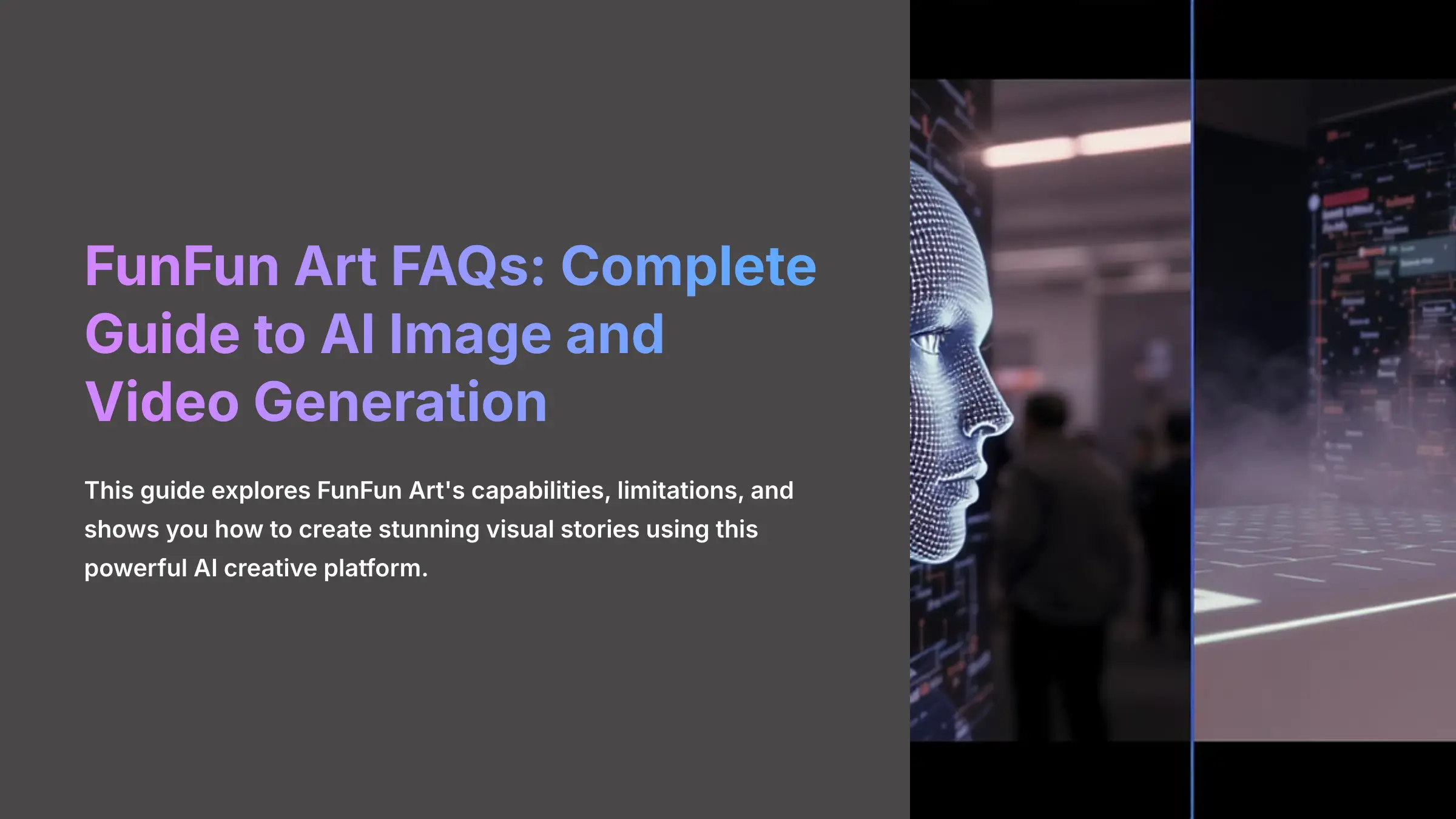

What is FunFun Art and how does it work?
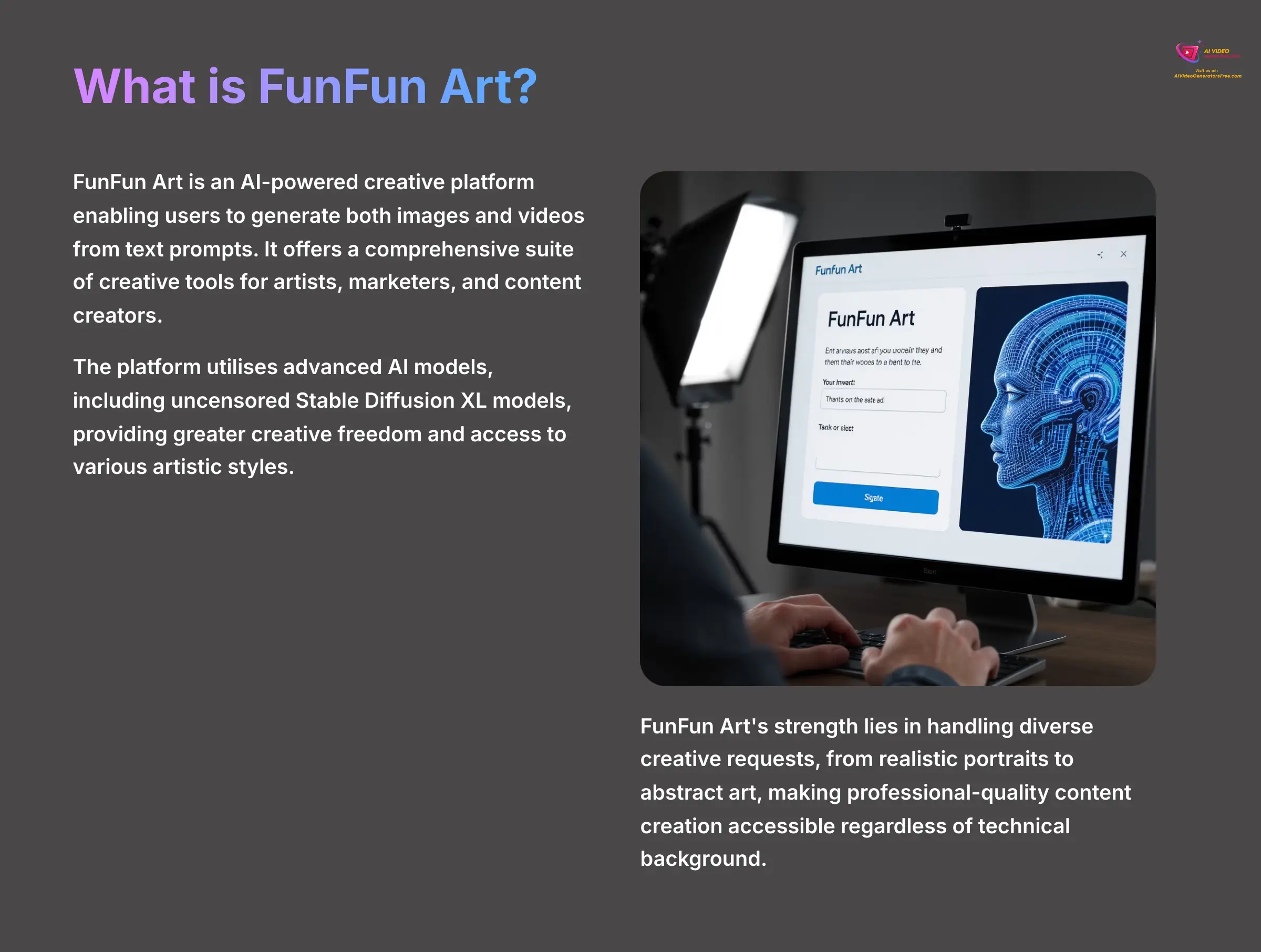

FunFun Art is an AI-powered creative platform that enables users to generate both images and videos from text prompts, offering a comprehensive suite of creative tools for artists, marketers, and content creators. Unlike platforms that focus solely on video generation, FunFun Art provides a versatile creative environment where users can experiment with both static and dynamic content creation.
The platform utilizes advanced AI models, including uncensored Stable Diffusion XL models, which provide users with greater creative freedom and access to a wide variety of artistic styles. When you input a text description, the AI interprets your prompt and generates high-quality visual content based on your specifications. The technology analyzes relationships between concepts, objects, styles, and compositions to produce coherent and visually appealing results.
FunFun Art's strength lies in its ability to handle diverse creative requests, from realistic portraits and landscapes to abstract art and stylized illustrations. The platform is designed to make professional-quality content creation accessible to users regardless of their technical background, handling the complex computational processes while providing an intuitive interface for creative expression. Whether you're creating social media content, marketing materials, or artistic projects, FunFun Art streamlines the creative process from concept to final output.
Is FunFun Art free to use with all features?
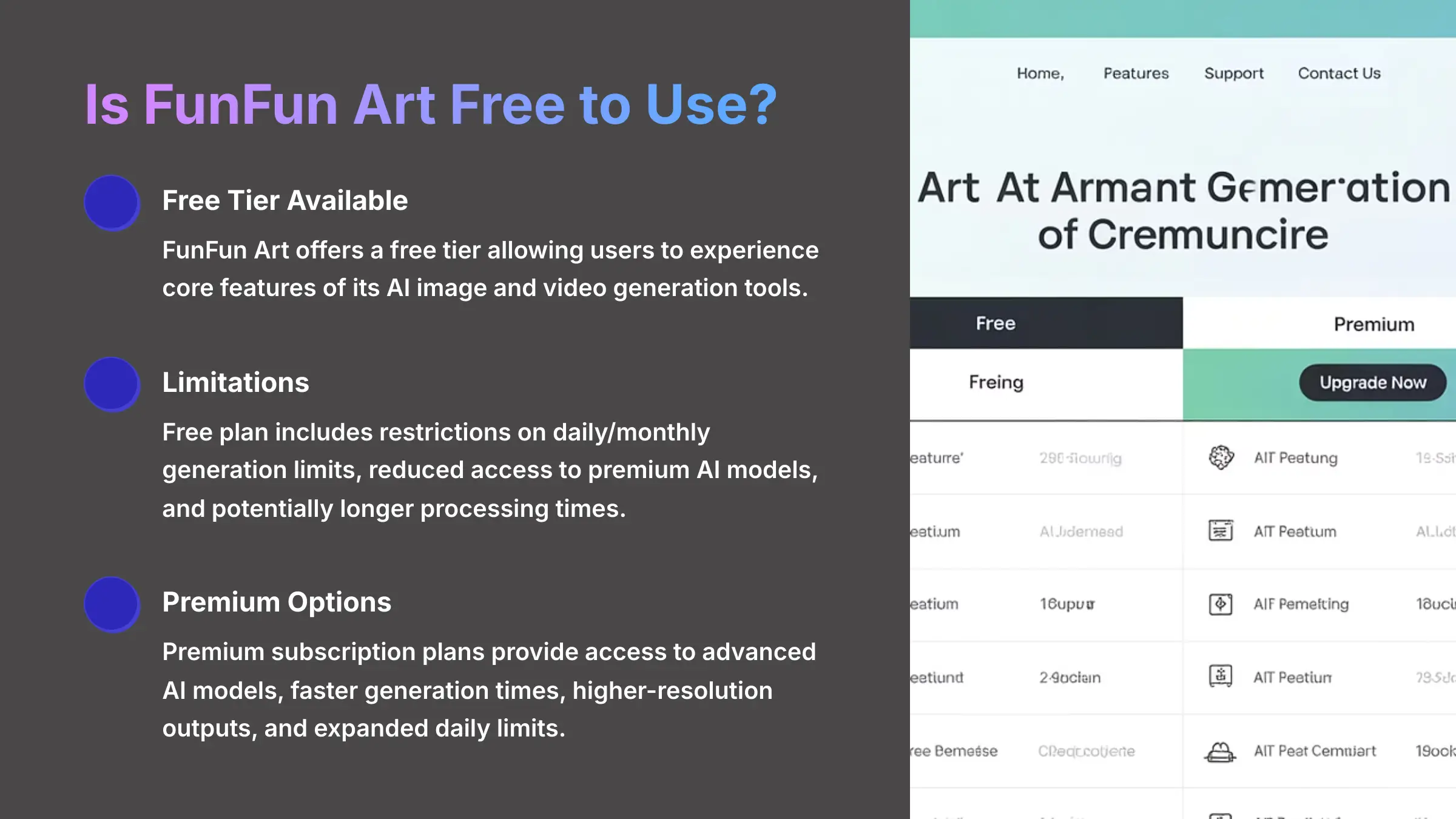

Yes, FunFun Art offers a free tier that allows users to experience the core features of its AI image and video generation tools. This free plan provides an excellent opportunity to test the platform's capabilities, experiment with different prompts, and evaluate the quality of generated content before committing to a subscription.
However, the free plan comes with certain limitations designed to balance accessibility with platform sustainability. These typically include:
- Restrictions on daily or monthly generation limits.
- Reduced access to premium AI models.
- Potentially longer processing times during peak usage periods.
- Limited access to advanced features like high-resolution outputs or batch processing.
For users requiring more comprehensive access, FunFun Art offers premium subscription plans that provide access to more advanced AI models, faster generation times, higher-resolution outputs, and expanded daily limits. Premium plans are particularly valuable for professional creators, businesses, or anyone who needs consistent, high-quality content generation without restrictions. The subscription structure allows casual users to explore the platform freely while providing serious creators with the tools and capacity they need for professional projects.
How does FunFun Art compare to Pika Labs and RunwayML for AI video creation?
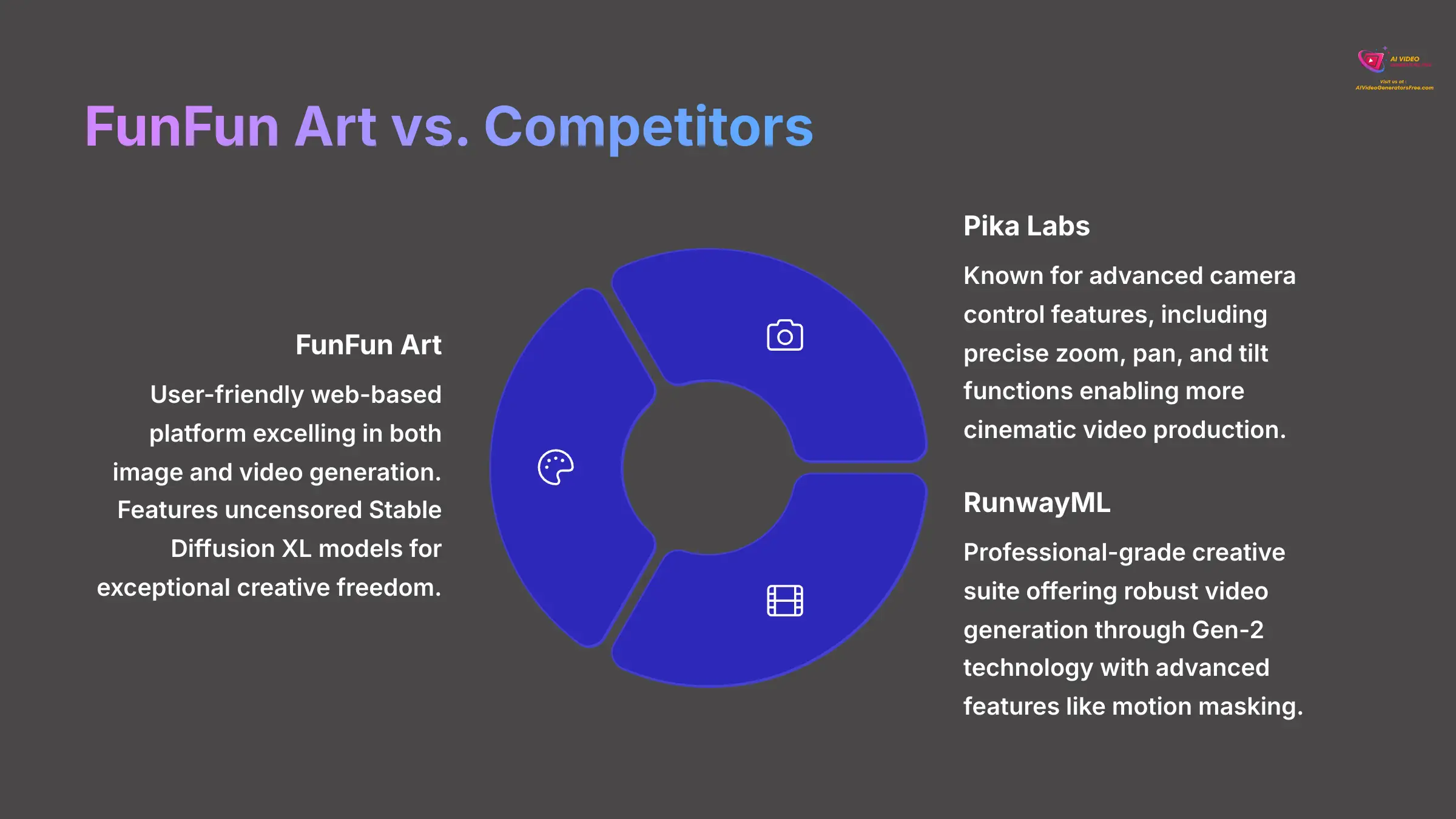

When evaluating AI video generation platforms, FunFun Art, Pika Labs, and RunwayML each offer distinct advantages depending on your specific creative needs and technical requirements. Understanding these differences is crucial for choosing the right platform for your projects.
| Feature | FunFun Art | Pika Labs | RunwayML |
|---|---|---|---|
| Primary Strength | Versatile image & video creation with high creative freedom (uncensored models). | Advanced camera controls (zoom, pan, tilt) for cinematic effects. | Professional-grade creative suite with robust features (Gen-2, motion masking). |
| Best For | Beginners and creators wanting diverse content types and artistic exploration. | Users seeking precise directorial control over camera movements. | Enterprise users and professional studios needing advanced tools and clear licensing. |
| Ease of Use | Very user-friendly, intuitive web-based interface. | Moderately easy, with a focus on specific cinematic controls. | Steeper learning curve due to an extensive, professional feature set. |
The choice between these platforms often depends on your primary use case: choose FunFun Art for versatile image and video creation with maximum creative freedom, Pika Labs for advanced camera control and cinematic effects, or RunwayML for comprehensive professional toolsets and enterprise-level features.
Can I access FunFun Art on my computer or is it mobile-only?
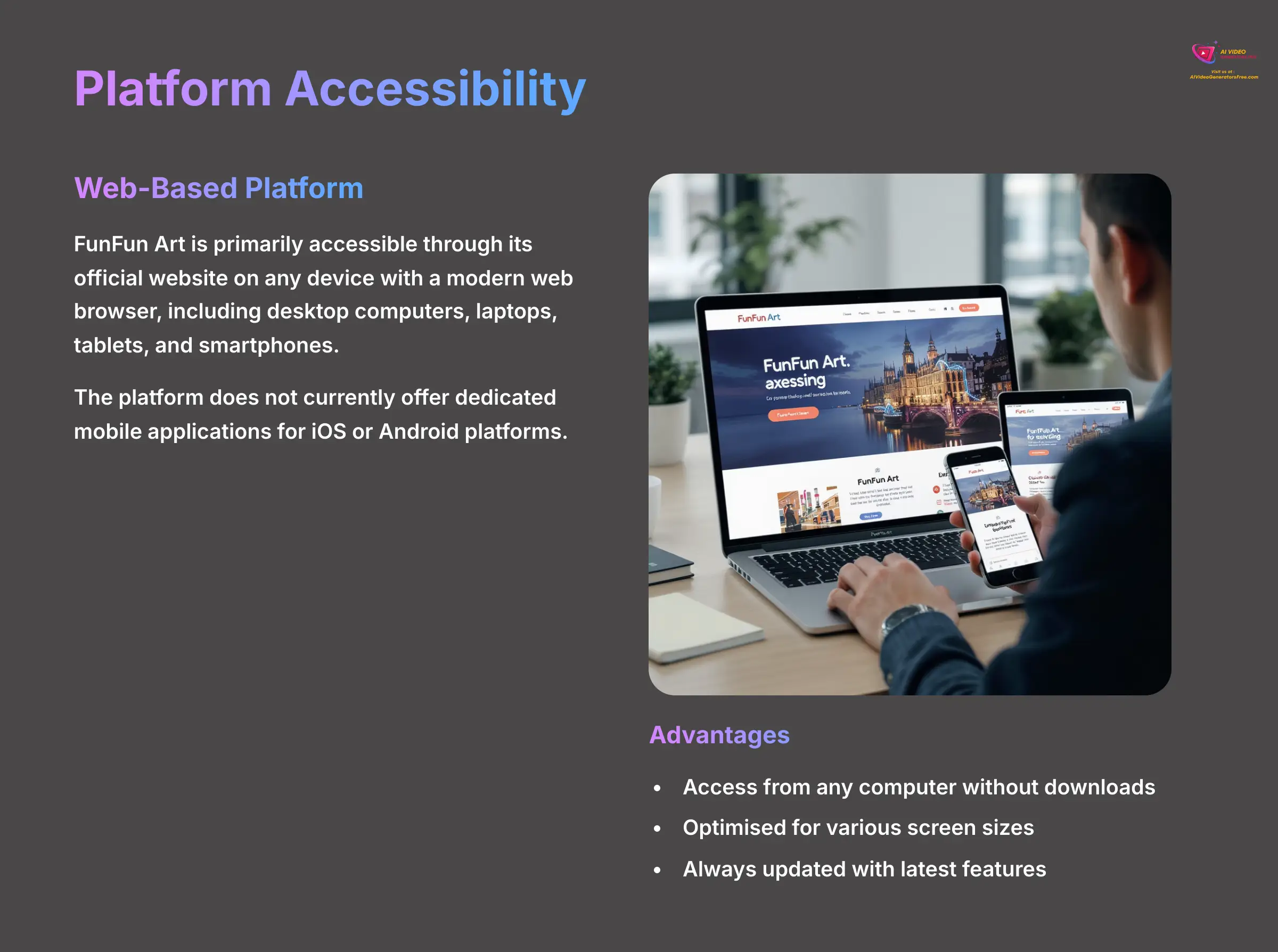

FunFun Art is primarily a web-based platform accessible through its official website, making it available on any device with a modern web browser, including desktop computers, laptops, tablets, and smartphones. Contrary to some assumptions, FunFun Art does not currently offer dedicated mobile applications for iOS or Android platforms.
This web-based approach provides several advantages for users:
- You can access FunFun Art from any computer without downloading or installing software.
- The web interface is optimized for various screen sizes, ensuring functionality across devices.
- You always have the latest version of the platform without needing to perform manual updates.
For users who prefer a desktop workflow, accessing FunFun Art through a web browser on your PC or Mac provides the full functionality of the platform with the convenience of a larger screen and traditional keyboard and mouse input. This setup is particularly beneficial for detailed creative work, batch processing, or when you need to easily save and organize your generated content locally.
What are the main limitations I should know about before using FunFun Art?
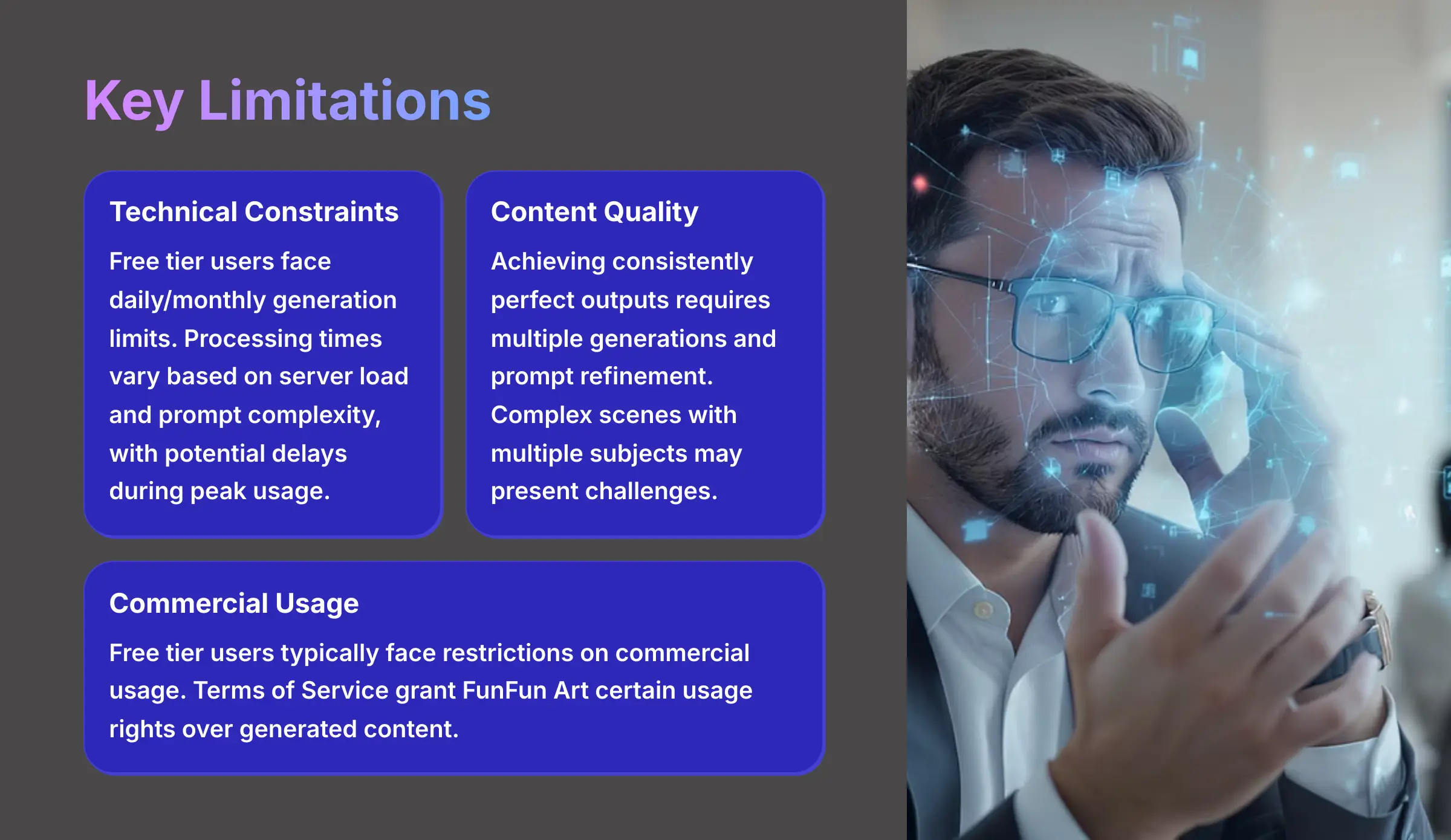

Understanding FunFun Art's limitations helps set appropriate expectations and enables you to plan your creative projects effectively. While the platform offers powerful AI generation capabilities, there are several key constraints to consider.
Technical limitations primarily revolve around generation capacity and processing constraints. Free tier users face daily or monthly limits on the number of images and videos they can generate, which may restrict extensive experimentation or high-volume content creation. Processing times can vary based on server load and the complexity of your prompts, with peak usage periods potentially resulting in longer wait times.
Content and quality considerations include the inherent variability in AI-generated outputs. While FunFun Art produces high-quality results, achieving consistently perfect outputs may require multiple generations and prompt refinement. Complex scenes with multiple subjects, intricate details, or specific technical requirements may present challenges and require iterative approaches to achieve desired results.
Commercial usage rights and licensing terms vary significantly between free and premium tiers. Free tier users typically face restrictions on commercial usage, meaning generated content may only be suitable for personal projects. The platform's Terms of Service also grant FunFun Art certain usage rights over generated content, which may impact how you can use or distribute your creations.
Resolution and format limitations may affect professional applications. While the platform generates high-quality content, specific output resolutions, file formats, or advanced export options may be limited compared to specialized professional software. Understanding these constraints helps you determine whether FunFun Art meets your specific project requirements or if additional tools may be necessary for your workflow.
How can I create better quality images and videos with FunFun Art?
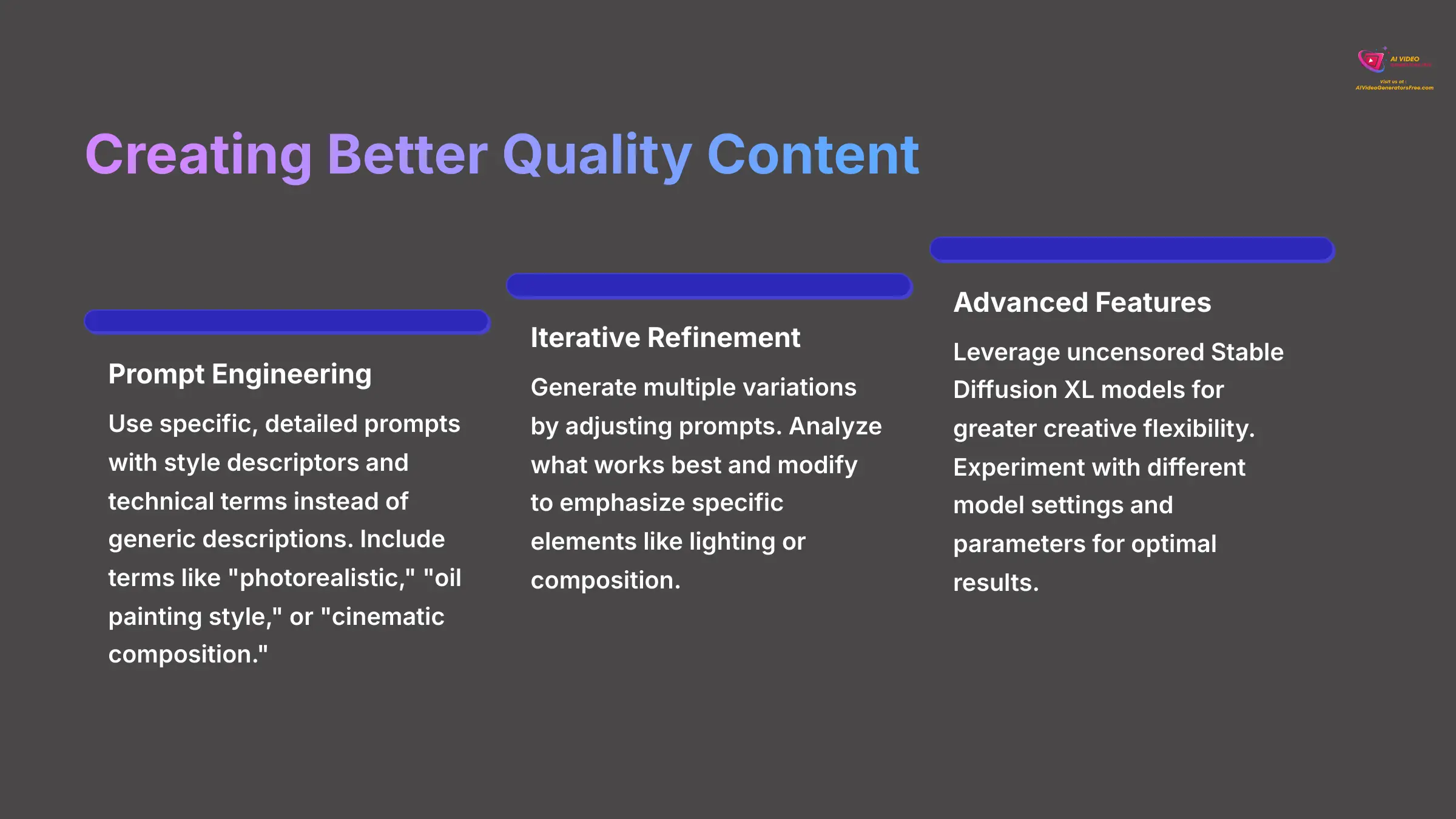

Achieving consistently high-quality results with FunFun Art requires understanding both the technical aspects of AI generation and effective creative strategies. Mastering these techniques significantly improves your output quality and creative satisfaction.
Prompt engineering forms the foundation of quality AI generation. Instead of generic descriptions like “a beautiful landscape,” use specific, detailed prompts such as “a misty mountain valley at dawn with golden sunlight filtering through pine trees, photographed with a wide-angle lens, cinematic composition.” Include style descriptors like “photorealistic,” “oil painting style,” or “digital art” to guide the AI toward your desired aesthetic. Technical photography terms like “shallow depth of field,” “dramatic lighting,” or “high contrast” can enhance visual impact.
Iterative refinement is crucial for optimal results. Generate multiple variations of your concept by slightly adjusting your prompts, then analyze what works best. If a generated image has excellent composition but poor lighting, modify your prompt to emphasize lighting conditions. This iterative approach helps you understand how the AI interprets different descriptive elements and improves your prompting skills over time.
Leverage FunFun Art's advanced features and models effectively. The platform's uncensored Stable Diffusion XL models offer greater creative flexibility, allowing for more diverse artistic expressions. Experiment with different model settings and parameters to find combinations that work best for your specific creative goals.
Quality control strategies are also key. Here are some tips:
- Generate content at the highest available resolution.
- Use reference images when possible to guide style and composition.
- Understand that shorter, focused prompts often work better than extremely long descriptions.
- Use specific artistic and technical terminology for more controlled results.
Do I own the content I create and can I use it commercially?
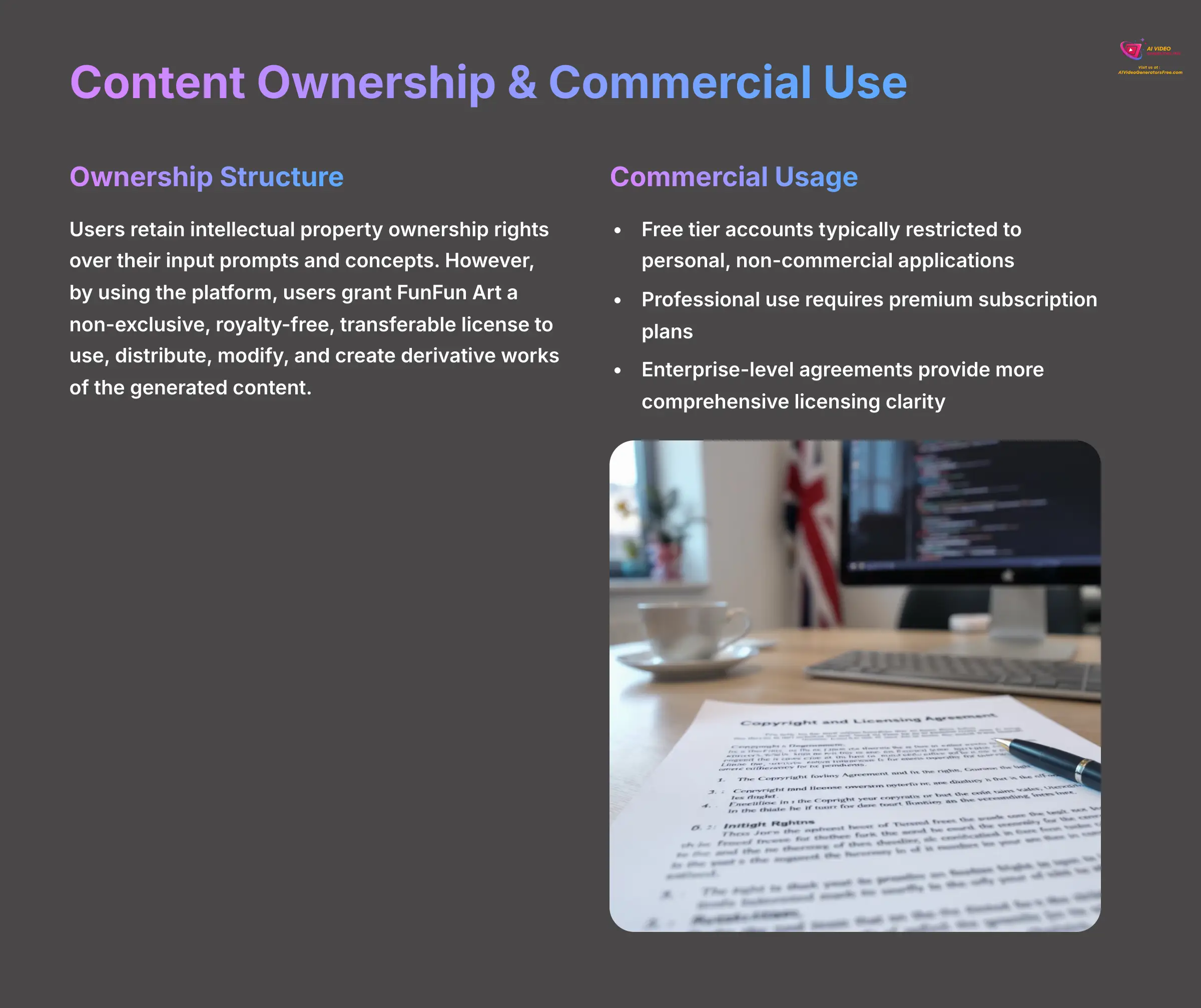

Content ownership and commercial usage rights with FunFun Art involve important legal considerations that vary significantly between subscription tiers. Understanding these terms is crucial for anyone planning to use generated content professionally or commercially.
According to FunFun Art's Terms of Service, users retain intellectual property ownership rights over their input prompts and concepts. However, the platform's licensing terms are more complex regarding the generated output. By using the platform, users grant FunFun Art a non-exclusive, royalty-free, transferable, sub-licensable, worldwide license to use, distribute, modify, run, copy, publicly display, translate, or create derivative works of the generated content in a manner consistent with their Privacy Policy.
This licensing arrangement means that while you maintain ownership of your creative input, FunFun Art retains significant usage rights over the generated content. This structure is common among AI generation platforms but has important implications for commercial use, particularly for businesses or professional creators who require exclusive control over their content.
Commercial usage rights are typically restricted on free tier accounts, limiting generated content to personal, non-commercial applications. Professional or commercial use usually requires upgrading to premium subscription plans, which often provide clearer commercial licensing terms and may reduce the platform's usage rights over your generated content.
For serious commercial applications, especially those involving client work, marketing campaigns, or content resale, it's essential to carefully review the current Terms of Service and consider contacting FunFun Art directly to clarify licensing terms. Some businesses opt for enterprise-level agreements that provide more comprehensive licensing clarity and legal protections. Always ensure your intended use aligns with the platform's current terms before proceeding with commercial applications.
Does FunFun Art add watermarks to generated content?
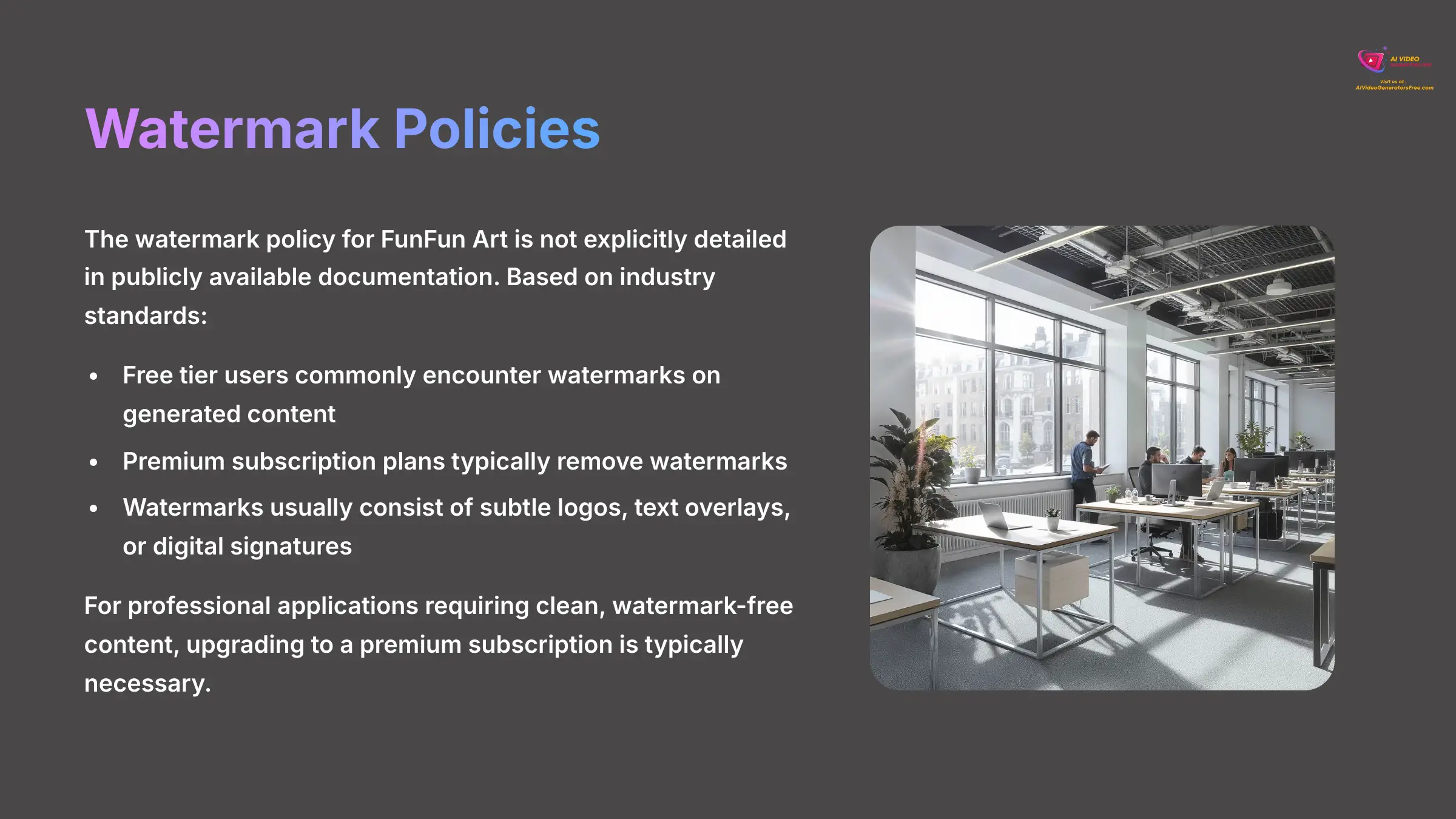

The watermark policy for FunFun Art generated content is not explicitly detailed in publicly available documentation, which means users should verify current policies directly through the platform. However, based on industry standards for AI generation platforms, watermark practices typically vary between subscription tiers.
Most AI generation platforms, including those offering free tiers, implement watermarks as a way to maintain attribution and encourage premium subscriptions. Free tier users commonly encounter watermarks on their generated content, usually consisting of subtle logos, text overlays, or digital signatures embedded in the final output. These watermarks serve dual purposes: they provide attribution to the generation platform and create an incentive for users to upgrade to premium plans for clean, professional output.
Premium subscription plans typically remove watermarks from generated content, providing clean outputs suitable for professional use, marketing materials, and client projects. This watermark removal is often one of the primary benefits that justify premium subscription costs for professional creators and businesses.
To determine FunFun Art's specific watermark policy, users should check their account settings, review the current subscription plan details, or generate a test image to observe whether watermarks are applied. The platform's terms of service or help documentation may also specify watermark policies for different subscription tiers.
What subscription plans does FunFun Art offer and what's included?
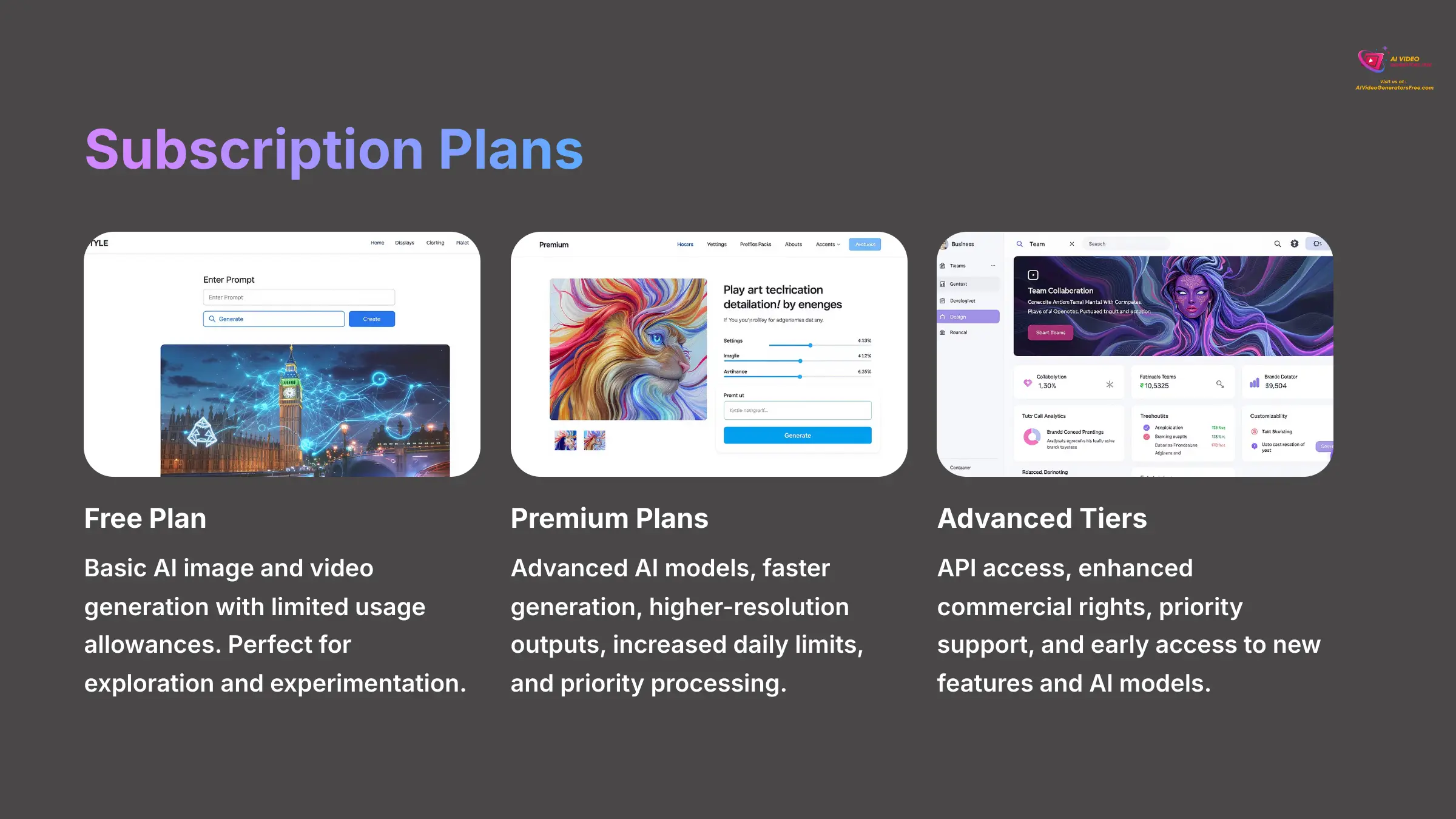

FunFun Art offers both free and premium subscription plans designed to accommodate different user needs, from casual experimentation to professional content creation. The tiered approach allows users to start with basic features and upgrade as their requirements grow.
The free plan provides access to basic AI image and video generation tools with limited usage allowances. This tier is perfect for users who want to explore the platform's capabilities, experiment with different prompts, and evaluate whether FunFun Art meets their creative needs. Free tier limitations typically include daily or monthly generation limits, restricted access to premium AI models, and potentially longer processing times during peak usage periods.
Premium subscription plans unlock significantly enhanced capabilities, including:
- Access to more advanced AI models (like uncensored Stable Diffusion XL).
- Faster generation times and priority processing.
- Higher-resolution output options.
- Increased daily limits or unlimited generations.
- Access to specialized features like batch processing or advanced style controls.
Advanced subscription tiers may offer additional professional features such as API access, enhanced commercial usage rights, priority customer support, and early access to new features and AI models. For businesses and professional creators, these higher-tier plans often provide the reliability, support, and licensing clarity necessary for commercial applications.
To access current pricing and detailed plan comparisons, users should visit the FunFun Art website directly, as subscription offerings and pricing can change based on platform updates and market conditions.
How does FunFun Art ensure user privacy and data security?
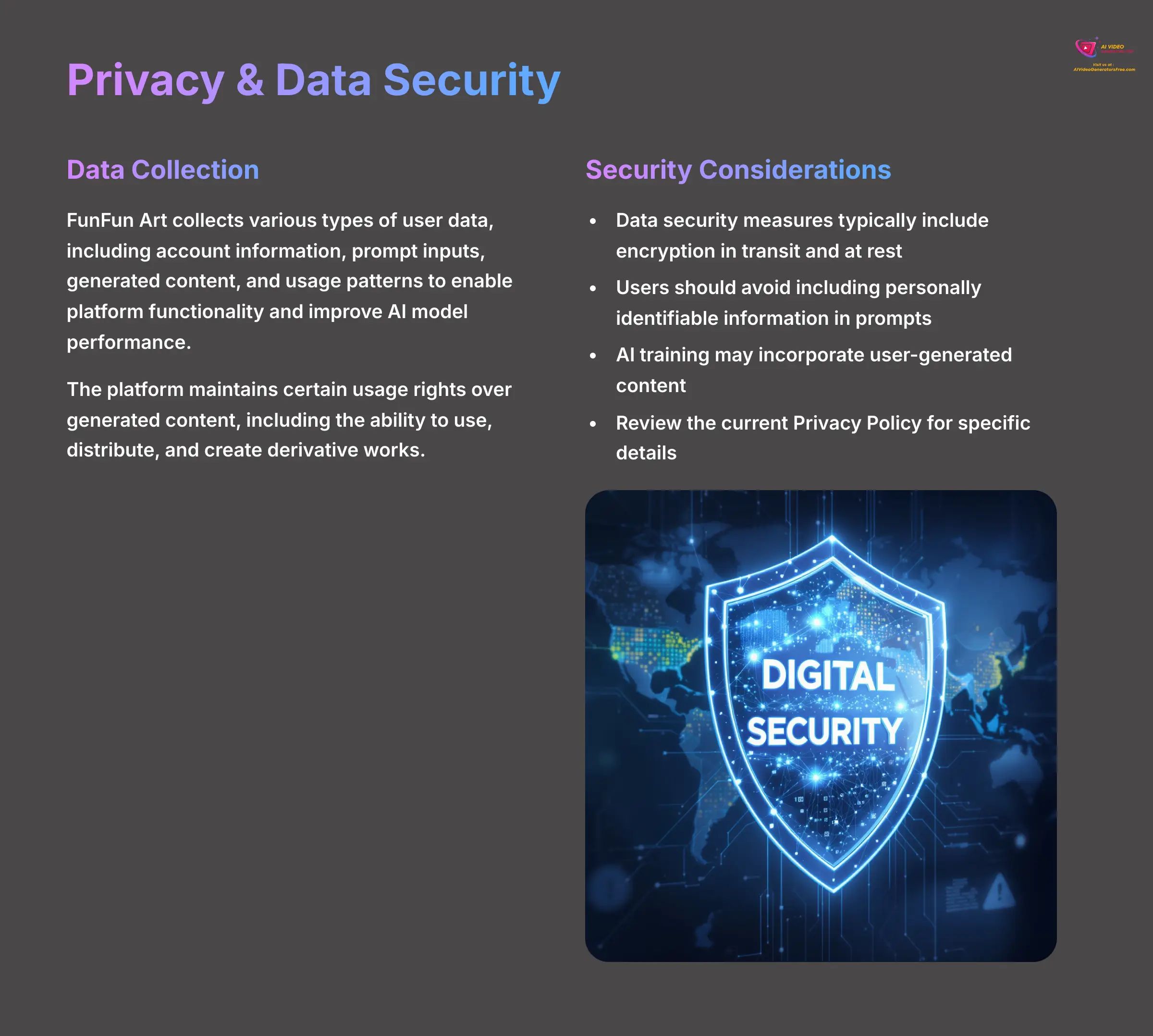

User privacy and data security are critical considerations when using any AI generation platform, as these services process personal prompts, generated content, and user account information. FunFun Art's approach to privacy and security should be evaluated through their official Privacy Policy and Terms of Service.
AI generation platforms typically collect various types of user data, including account information, prompt inputs, generated content, and usage patterns. This data collection enables platform functionality, improves AI model performance, and supports user account management. Understanding what data is collected, how it's used, and how long it's retained is essential for users concerned about privacy.
FunFun Art's Terms of Service indicate that the platform maintains certain usage rights over generated content, which includes the ability to use, distribute, and create derivative works from user-generated content. This arrangement, while common in the industry, means that users should be mindful of the sensitive or proprietary nature of their prompts and generated content.
Data security measures typically include encryption of data in transit and at rest, secure server infrastructure, and regular security audits. However, specific details about FunFun Art's security implementations should be verified through their official documentation or by contacting their support team directly.
For users with heightened privacy concerns, particularly those working with sensitive or proprietary content, it's advisable to review the platform's current Privacy Policy thoroughly and consider whether the terms align with their privacy requirements. Some users opt to avoid including personally identifiable information or sensitive business details in their prompts to minimize potential privacy risks.
Users should also be aware that AI training processes may incorporate user-generated content to improve model performance, though reputable platforms typically anonymize this data and provide opt-out mechanisms for users who prefer not to contribute to training datasets.
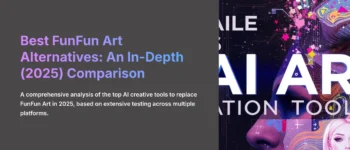
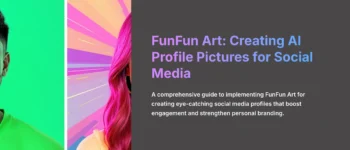
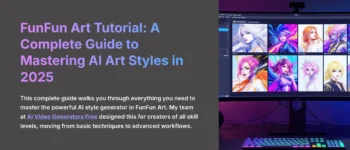
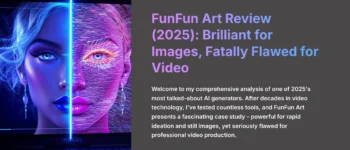



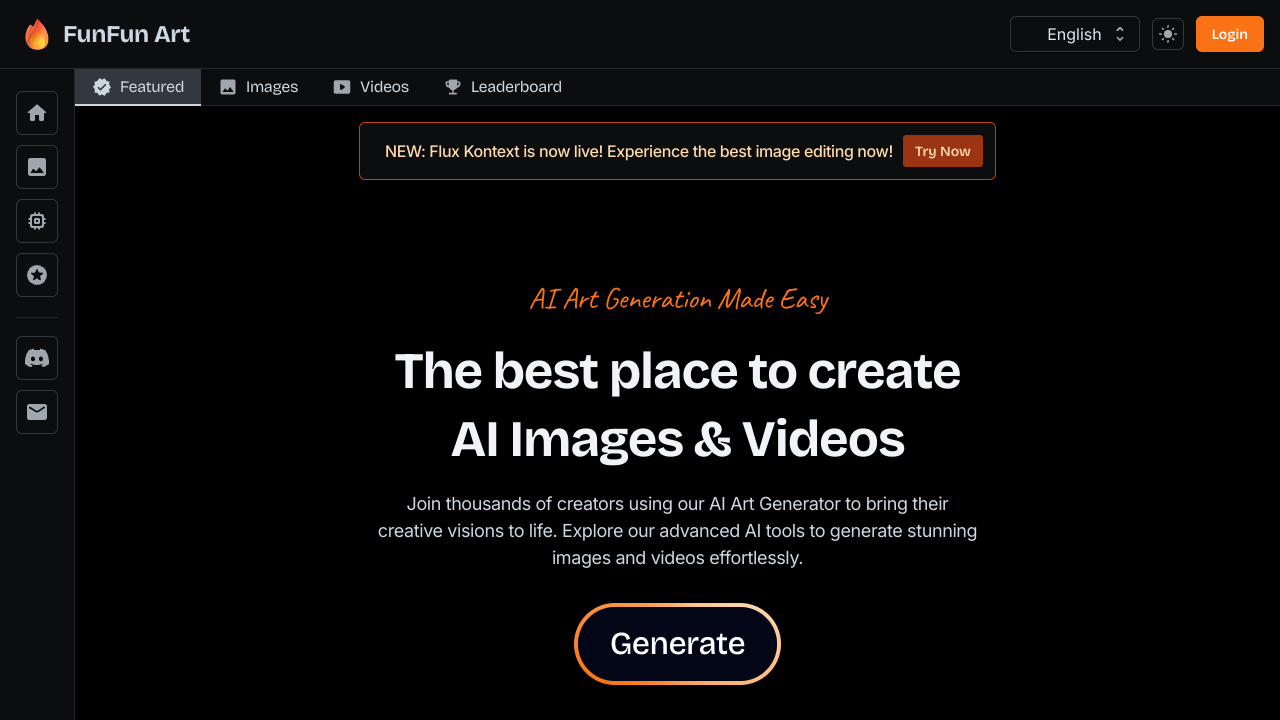

Leave a Reply